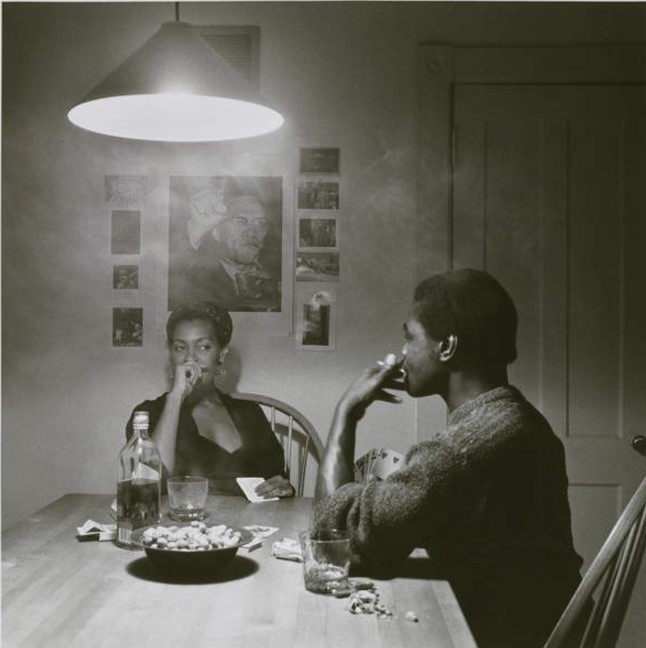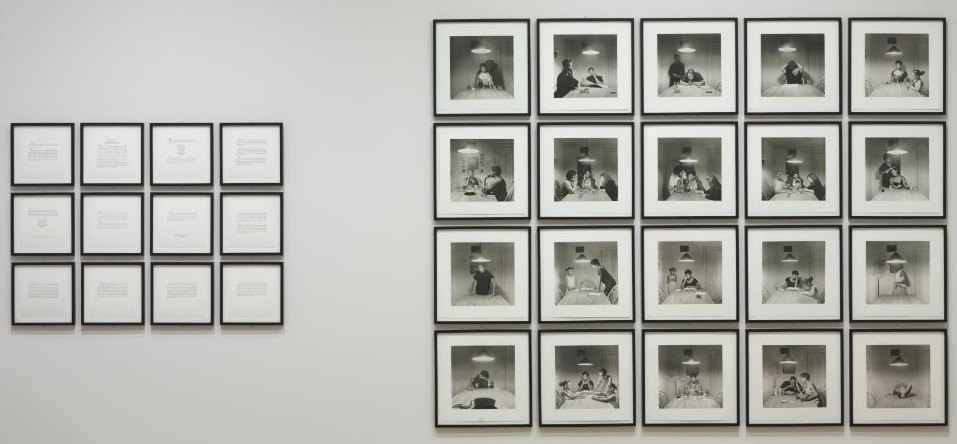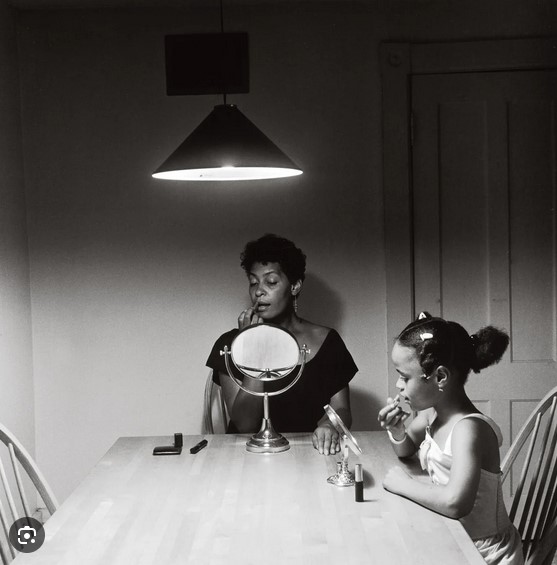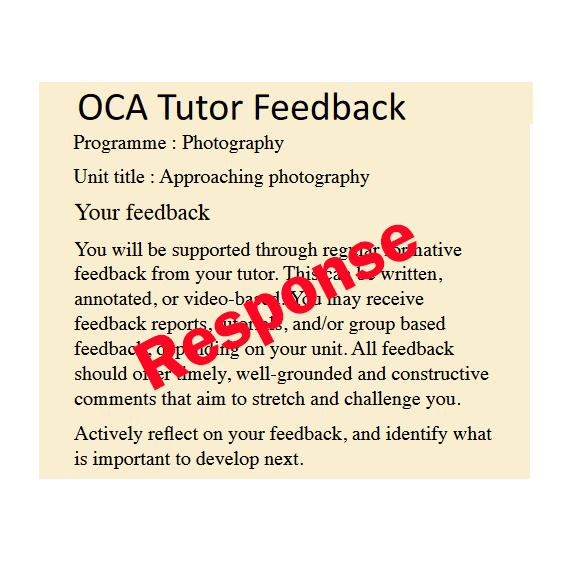A Critical Analysis of the monochrome photograph of man and woman playing cards at a Kitchen table. The man is smoking.

Denoted in the image, two people, a man and a woman, possibly a ‘couple’, at a table, playing cards over a drink and snacks. Behind them are photographs surrounding a large portrait of a man who looks as though he is pointing out, or to something.
What I saw (connoted) in the image was the woman considering the man, perhaps considering what to play from her hand of cards. The man also seems to be in a typical card player’s ‘cool’ pose, attempting to keep a poker face, giving nothing away. We can see that he has ‘hearts’ in his hand of cards. I feel as though I’m sitting at the other end of the table, a voyeur, I want to say “hold your hand up I can see it!” The central light focuses attention on the table.
Semiotics: reading the signs!
The image has no title, but does have the barest of descriptions, I find it interesting that the man smoking is included . Whilst descriptive, it ignored the obvious alcohol, empty glasses, peanuts and empty shells that clearly signifies a social, interactive occasion. Is this some reference to something in the cigarette that I am not aware of … weed, hash or whatever it is called now.
There is the large poster portrait on the wall behind the card players. It is a photograph of Malcolm X. This locates some of the photographer’s intentions indicating the image relates to notions of empowerment.
Reading further, I looked at a fellow student’s critical analysis [Stephen Ward], I realise that I just do not know enough about black American culture to appreciate the more obscure messages encoded in the image. These in particular:
- Smoky atmosphere, the alcohol suggest Jazz clubs and speakeasies where men dominated.
- Peanuts it is suggested is a reference to a variety of racial slurs and tensions . The ‘peanut gallery’ in a theatre where the segregated blacks were allowed. A baseball player in 2017 (Adam Jones) suffered abusive behaviour where peanuts were thrown at him.
These symbols add up to a possible preferred reading of the image that involves black power, sexual and domestic politics played out through a game of cards in the kitchen. These may be incidental interpretations, however, the image is presented to us as an isolated image where it may need to be seen one of the series of 20 to which it belongs: ‘The Kitchen table’, by Carrie Mae Weems 1990.

Each image is a staged composition by the photographer, who is the woman in each of the scenes. Indeed some writers speak of the ‘story’ moving from one ‘frame to another [Anderson]. The time stamp of 1990 puts the image we are examining in a time before the ubiquitous intrusion into our lives of leisure time access to digital and electronic devices. Hence, here, we see an activity that was once more common place. Other images in the series are less ‘dated’.
The series title given by the photographer gives us a more concrete idea of the purpose of the images. Putting the image in the context of a woman’s role in a kitchen and around its table, where the family meets as meals are made and eaten, and where all elements of daily life take place, it is inferred that many political and social ‘conflicts’ occur there.
The oppositional ‘readings’ that I have found include:
A kitchen table might be: “associated with oppressive representations of domesticity” [Scharnhorst, R. (2019) ] and perhaps that is an aspect of Weem’s project, although not a version I considered as vehemently stated as this. In the image(s) the woman didn’t look overly oppressed.
“Together the images and texts suggest that while the woman is many things to others, she is first and foremost rooted in herself.” This is part of a description for an exhibition at the Cleveland Museum of Art. The description is more about what the museum wants you to take away from a viewing, based on their feminist themes for exhibiting the collection, and is stronger than my reading and how I would express a reading of the image.
I wonder how relevant ‘the kitchen table’ as a symbol is to millennials and Gen Z. Modern kitchens have no room for a table, meals are eaten in front of the TV (or other digital viewer), do families or couples play cards or games? I wonder where domestic politics happen these days. This feels like a generalisation, however, relevance to the viewer’s experience is important if they are to make any associations that make sense to them.
Is it important that it is a black woman and man? There is a suggestion that all women can relate to the image in the narrative that surrounds the series. Although a possible ‘put off’ for some is the fuzzy image of Malcolm X on the wall suggesting a blanket of black empowerment over the image.
Despite all, if only focusing on game of cards, I was right back as a child of the 50’s and 60’s in a family who regularly played cards, around a table. The looks, the attempts at intimidation, the jostling for ‘place’, the attempts at posture reading, the ‘put downs’, the adult disappointment when mistakes were made. So job done Carrie Mai Weems with this one image, her image focused my attention on one of my experiences and made me reflect on how much of my later life choices were based on lessons learnt at a ‘kitchen’ table.
References
Anderson, A. (2021) Unpacking Things: The Kitchen Table Series, Mysite. Available at: https://www.fotosapien.co/post/the-kitchen-table-series (Accessed: 29 November 2024).
Barrett, Terry Photographs and Context (1997). Available at: https://terrybarrettosu.com/wp-content/uploads/2017/08/B_PhotAndCont_97.pdf (Accessed: 30 November 2024).
George Washington Carver: Facts, Inventions & Quotes (2023) HISTORY. Available at: https://www.history.com/topics/black-history/george-washington-carver (Accessed: 27 November 2024).
Growcoot, M. (2023) Almost All Photos Are Now Taken on Smartphones, According to Study, PetaPixel. Available at: https://petapixel.com/2023/06/20/almost-all-photos-are-now-taken-on-smartphones-according-to-study/ (Accessed: 29 November 2024).
How to decide which photos to use in your life story book (2022) Modern Heirloom Books. Available at: https://www.modernheirloombooks.com/new-blog/2022/7/4/how-to-decide-which-photos-to-use-in-your-life-story-book (Accessed: 29 November 2024).
Kitchen Table (no date) Carrie Mae Weems. Available at: https://www.carriemaeweems.net/kitchentable (Accessed: 29 November 2024).
Scharnhorst, R. (2019) ‘Composing at the Kitchen Table’, Graduate Journal of Food Studies, 06(01). Available at: https://doi.org/10.21428/92775833.23e3b720. (Accessed 24 November 2024)
Smarthistory – Carrie Mae Weems, Kitchen Table Series (no date). Available at: https://smarthistory.org/seeing-america-2/weems-kitchen-table-series/ (Accessed: 29 November 2024).
The Kitchen Table Series | Cleveland Museum of Art (no date). Available at: https://www.clevelandart.org/art/2008.116 (Accessed: 24 November 2024).
Kitchen Table Series (no date). Available at: https://www.nga.gov/collection/art-object-page.209288.html (Accessed: 29 November 2024).
Ward, Stephen: ‘Assignment 8 :Carrie Mae Weems – Untitled (Man smoking) contextualised’ (2022) Level 1: 1.1 Approaching Photography, 29 June. Available at: https://spaces.oca.ac.uk/stephenward1/category/assignments/assignment-8/assignment-8-carie-mae-weems-the-kitchen-table-series/ (Accessed: 24 November 2024).





